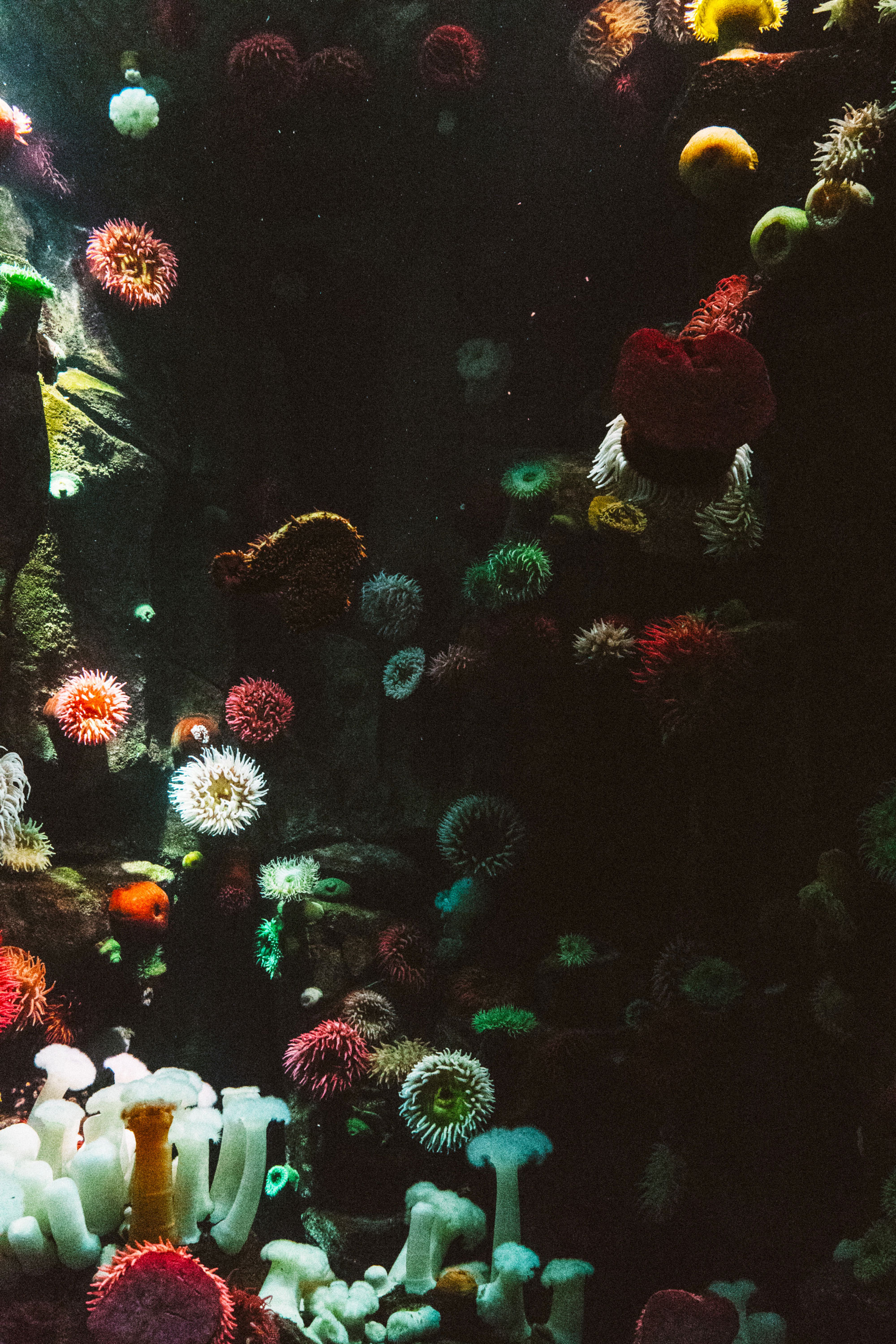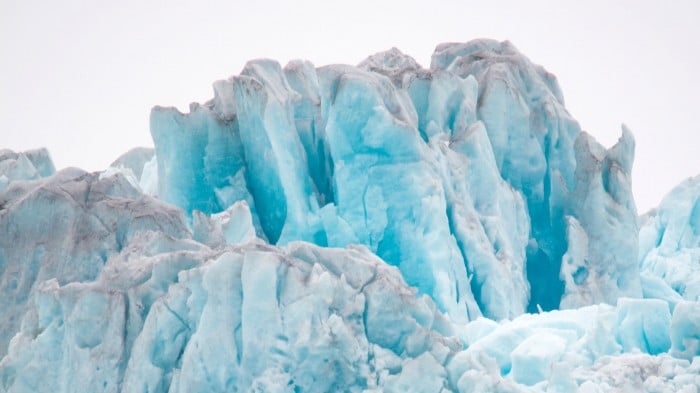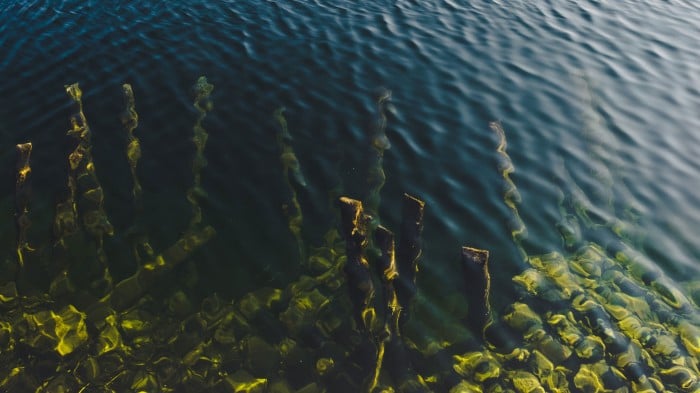The desperate race to cool the ocean before it’s too late
Holly Jean Buck is a fellow at UCLA’s Institute of the Environment and Sustainability. This is an adapted excerpt from her upcoming book After Geoengineering: Climate Tragedy, Repair, and Restoration (September 2019, Verso Books).

Coral reefs smell of rotting flesh as they bleach. The riot of colors—yellow, violet, cerulean—fades to ghostly white as the corals’ flesh goes translucent and falls off, leaving their skeletons underneath fuzzy with cobweb-like algae.
Corals live in symbiosis with a type of algae. During the day, the algae photosynthesize and pass food to the coral host. During the night, the coral polyps extend their tentacles and catch passing food. Just 1 °C of ocean warming can break down this coral-algae relationship. The stressed corals expel the algae, and after repeated or prolonged episodes of such bleaching, they can die from heat stress, starve without the algae feeding them, or become more susceptible to disease.
Australia’s Great Barrier Reef—actually a 2,300-kilometer (1,400-mile) system made up of nearly 3,000 separate reefs—has suffered severe bleaching in the past few years. Daniel Harrison, an Australian oceanographer looking at what might be done to buy more time for the Great Barrier Reef, says the situation is getting dire. “There might be as little as 25% of shallow-water coral cover left from pre-anthropogenic times. We don’t really know, because nobody started surveying before 1985,” he tells me. “You’ve got less than 1% of the ocean in coral reefs, and 25% of all marine life. We’re looking at losing all of that really quite quickly, in evolutionary terms. In human-lifetime terms.”
Coral reefs are not just about colorful fish and exotic species. Reefs protect coasts from storms; without them, waves reaching some Pacific islands would be twice as tall. Over 500 million people depend on reef ecosystems for food and livelihoods. Even if the temperature increase eventually stabilizes at 1.5 °C a century or two from now, it’s not known how well coral reef ecosystems will survive a temporary overshoot to higher temperatures.
The corals are like the canary in the coal mine.
The corals are like the canary in the coal mine, Harrison says: “They’re very temperature-sensitive. I really do think it’s just a harbinger of things to come. You know, the coral ecosystem might collapse first, but I think there might be quite a few more ecosystems that’ll follow it. Life is very resilient, but ecosystems as we know them aren’t.”
Arctic ecosystems, mountain glaciers, and the redwood forests in California are also at high risk from even small changes in global mean temperature. So are species that can’t move quickly and find another suitable niche. “It’s the things that already live at the kind of extreme ends of the scale, and that can’t move, right?” says Harrison. “So coral reefs—you know, they’re stuck in already some of the warmest waters. If it gets too hot for them there, then a) they can’t move, and b) they’ve got nowhere to go anyway. And the same with the extremely cold ecosystems. And the same with the redwood forests. Trees can’t up and move quickly enough to keep up with climate change.”
The salt sprayer
Harrison’s working group formed teams to look at different ideas that could help the reef stay alive. For example, the ocean is full of cooler water at lower depths. They wondered if they could just pump some of that water upward but realized it would be infeasible to move enough water to cool the whole reef.
Instead the researchers homed in on the idea of marine cloud brightening—a form of solar geoengineering, in that it increases the planet’s reflectivity. Spraying tiny salt particles from seawater up into the low layer of clouds that blankets much of the ocean’s surface would form cloud micro-droplets. These droplets would make the clouds reflect more sunlight and could also make them last longer, cooling the area. The modeling Harrison’s team has done so far suggests that with this method it might be possible to cool the water by between 0.5 and 1 °C.
The Marine Cloud Brightening Project, an international collaboration led by atmospheric scientist Robert Wood and colleagues at the University of Washington, thinks that this could be a scalable approach. Kelly Wanser, a senior advisor to the project, describes other ways scientists are thinking of sustaining corals, such as genetically modifying or breeding them to withstand warmer waters, or moving robust corals into new areas and replanting them. But, she says, “the scale of the problem is like reinforcing the Rocky Mountains. It’s massive.”
By contrast, brightening marine clouds is relatively simple. Essentially, it entails building devices to spray seawater. “There’s certainly some technical challenges to be overcome, but the basic process of just taking seawater and filtering it and then spraying it out, at submicron size, is not that difficult,” Harrison says. His modeling results suggest that there would probably need to be some stations a little way out at sea, just off the edge of the continental shelf—floating platforms or ships that would spray particles into the air. The whole project could cost $150 to $300 million per year. Expensive, but then the reef brings in an estimated $6 billion each year to the Australian economy. In Harrison’s conception, you wouldn’t need to brighten the clouds all the time, or even every summer. Rather, it would be done when the coral was at risk of bleaching, which would require about two weeks of forewarning to cool the water down to the maximum extent.

“But, I mean, there’s some real unknowns here, right?” Harrison says. “Because no one’s ever done any field work on this.”
Even though the engineering might be relatively simple, it’s hard to know how well marine cloud brightening would work, because clouds are really complex. “If you look out the window on an airplane, you can see clouds with all sorts of different structures,” says Ben Kravitz of Indiana University, who works on comparing geoengineering model simulations. “They’re moving. Some of them are a couple meters across, some of them are tens of kilometers across. Some of them are organized, some are not. Basically, you can’t fit all that behavior in any single model.”
Adding to this complexity are “teleconnections” in the climate system—that is, clouds in one place affect weather in another place. When you’re trying to cool large areas, these long-distance effects are relevant. That’s why “it scares me, the thought of doing marine cloud brightening,” says Anthony Jones, a climate scientist at the University of Exeter. “The teleconnections are almost unavoidable, and if you can cool a certain area significantly, you are going to change the climate and the weather response.”
Reckoning with geoengineering in all its forms means coming to terms with loss.
Newer climate models may yield better estimates of how effective marine cloud brightening could be. Wanser of the Marine Cloud Brightening Project says the next step is to build and test nozzles for spraying seawater. But it’s been difficult to raise funding, because the project is seen as a geoengineering experiment, and people are fearful of geoengineering. “I think we talked to all of the relevant government agencies who could support this, and essentially there’s no one willing to say ‘We’ll just do it as the cloud-aerosol basic science,’” she says. “They’re like, ‘No, the cat’s out of the bag—this is geoengineering. We would have to get approval.’”
So cloud brightening is a technique that might help save marine ecosystems, but we don’t know how well it would work, and we can’t find out because the stigma of geoengineering makes it hard to get research funding. Luckily, it isn’t the only option for trying to cool the oceans.

The seaweed forests
Trees suck up carbon dioxide, and so planting masses of new forests has been proposed as a way to lower carbon dioxide concentrations in the atmosphere and thereby cool the earth. But there’s only so much land available. Enter “ocean afforestation,” a concept outlined in a 2012 paper by Antoine de Ramon N’Yeurt of the University of the South Pacific and colleagues. This proposal for cultivating seaweed for carbon removal has several steps. First, the seaweed needs to grow and be harvested. Then it’s put into an anaerobic digester—a large, oxygen-free tank that breaks the organic material down. That produces biogas, which is about 60% methane and 40% carbon dioxide. The methane can be used as a biofuel, while the carbon dioxide needs to be stored to keep it from going back into the atmosphere. (One idea is to store it inside a tube that would rest on the sea floor, though it could also be injected underground.) The advantage of using seaweed in this way is that it’s fast-growing and doesn’t require dry land, so it won’t be competing with food production or forests.
N’Yeurt and his fellow researchers calculated that afforesting 9% of the world’s ocean surface and processing the resultant biofuels could replace fossil fuel energy, increase sustainable fish production, and remove 53 billion tons of carbon dioxide from the atmosphere each year. With current emissions at about 40 billion tons a year, this could mean actually lowering the CO2 level overall.
“Quickly implementing Ocean Afforestation would be an effort on the order of putting a man on the moon, but both less expensive and likely a much better return on investment,” the paper’s authors wrote. But such an effort requires coordination from multiple scientific and engineering fields to even form demonstration projects. There aren’t institutions that work on this kind of holistic research and development.
On the other hand, as with cloud brightening, the basic technology of ocean afforestation is pretty simple. It requires advances in things like low-energy techniques for growing and harvesting seaweed, efficient gas separation, and carbon capture and storage—all building on things we already know how to do. The US government’s Advanced Research Projects Agency for Energy has a $22 million program called Mariner, an acronym for “macroalgae research inspiring novel energy resources,” for exploring innovations that could kick-start a seaweed industry.
Seaweed cultivation can have other benefits, too, such as cleaning up agricultural pollution. Fertilizer runoff from industrial agriculture pours nitrogen and phosphorus into the oceans. A 2017 paper in Nature Scientific Reports said that China’s seaweed industry already removes 75,000 tons of nitrogen and 9,500 tons of phosphorus from coastal waters each year—and that just 150% more seaweed cultivation could remove all the phosphorus flowing into Chinese coastal waters, though much more would be needed to deal with the excess nitrogen.
To capture these benefits we’ll need a well designed system, but right now the industry is mostly unregulated. Why does seaweed need regulating? For one thing, to prevent the spread of invasive species or diseases. For example, a bacterial disease called ice-ice infects a red seaweed called Kappaphycus, turning its branches into ghastly white icicles. The disease caused millions in crop losses in the Philippines and then spread to farms in Tanzania and Mozambique.
Another challenge is how to make seaweed farming an explicit part of climate policy. The definition of a carbon sink under the UN Framework Convention on Climate Change was written for trees. It doesn’t quite fit the profile for seaweeds—the carbon they draw down is easily decomposed and released again. Of course, there are ideas about how to sequester the biomass—sinking it into the deep sea, or into submarine canyons. But the current UN policy means that seaweed will be primarily cultivated for food, biofuels, and other products, rather than with carbon sequestration expressly in mind.
Yet another obstacle to using seaweed for carbon removal is climate change itself, which is already decimating natural kelp forests, for instance. One scientific report describes the urchin barrens that are settling in where kelp forest used to be; these warm-water species mow down everything in their path. Apparently, they are “almost immune to starvation” and some species live for over five decades. When they are stressed by hunger, their jaws and teeth actually enlarge, and they form fronts that march across the sea floor hunting for food. They’re just one instance of how climate change makes all kinds of agriculture trickier.
Putting the brakes on glaciers
Besides upsetting ecosystems, ocean warming will, of course, raise sea levels. They are already 13 to 20 centimeters (5 to 8 inches) higher than in 1900. In the 20th century, most of this rise came from ocean waters expanding as they got warmer, but now the effects of melting glaciers and ice sheets have far overtaken thermal expansion. The rise produced by melting glaciers is projected to be staggering—on the order of meters per century.
But what if we could engineer specific glaciers to keep them from melting? John Moore, a glaciologist and leader of China’s geoengineering research program, has recently been looking into this, and he wrote a comment with colleagues in Nature that outlines a few ways to do it.
One example involves two Antarctic glaciers scientists have a nervous eye on: Pine Island and Thwaites. Warm ocean water comes in underneath them. Conventional wisdom says this is unstoppable and irreversible, because of the bedrock slope and geometry. But Moore suggests that building artificial islands in front of the glaciers could buttress them, pinning down the ice and holding it back the way natural rocks and islands do.
Another technique would be to extract water from below the glaciers to keep them from sliding off into the ocean. Glaciers sit on subglacial streams, or thin layers of water, but drying these streams could slow their slide into the sea.
Moore says he sees this as a “very democratic, egalitarian way” of dealing with sea-level rise: “Instead of trying to build walls around all the world’s coastline— which actually means the rich countries will do it more than the poor countries, of course—you can deal with the problem at the source, where you have something on the scale of a hundred kilometers to deal with instead of tens of thousands of kilometers of coastline to deal with.” The engineering expertise exists, he says—“Look at things such as the construction of the Suez Canal or the building of Hong Kong’s new airport.”
“When we’ve talked about this with glaciologists, there’s a lot of horror at first,” Moore adds. “Clearly you’re going to have to put some people [in Antarctica] with a lot of stuff. That definitely will mess with the environment and the ecology. But if you compare the damage due to the collapse of the ice sheet, that’s kind of dwarfed.”
Living in the ruins
Moore’s ideas might be just a thought experiment for now, but we need more thought experiments. Reckoning with geoengineering in all its forms means coming to terms with loss—to explore what it means to “live in the ruins,” in anthropologist Anna Tsing’s phrase. Geoengineering comes as a shock to the mind of people who don’t currently feel as if they are living in the ruins, who haven’t yet come to terms with the losses being experienced. In Beijing, though, where Moore lives, it’s different, particularly because of air pollution. “There’s no denial—everyone can see what we’re doing,” he says. “We’ve made this mess; we should clear it up. You can’t rely on nature to do it.”
Keep Reading
Most Popular
How scientists traced a mysterious covid case back to six toilets
When wastewater surveillance turns into a hunt for a single infected individual, the ethics get tricky.
The problem with plug-in hybrids? Their drivers.
Plug-in hybrids are often sold as a transition to EVs, but new data from Europe shows we’re still underestimating the emissions they produce.
What’s next for generative video
OpenAI's Sora has raised the bar for AI moviemaking. Here are four things to bear in mind as we wrap our heads around what's coming.
Stay connected
Get the latest updates from
MIT Technology Review
Discover special offers, top stories, upcoming events, and more.